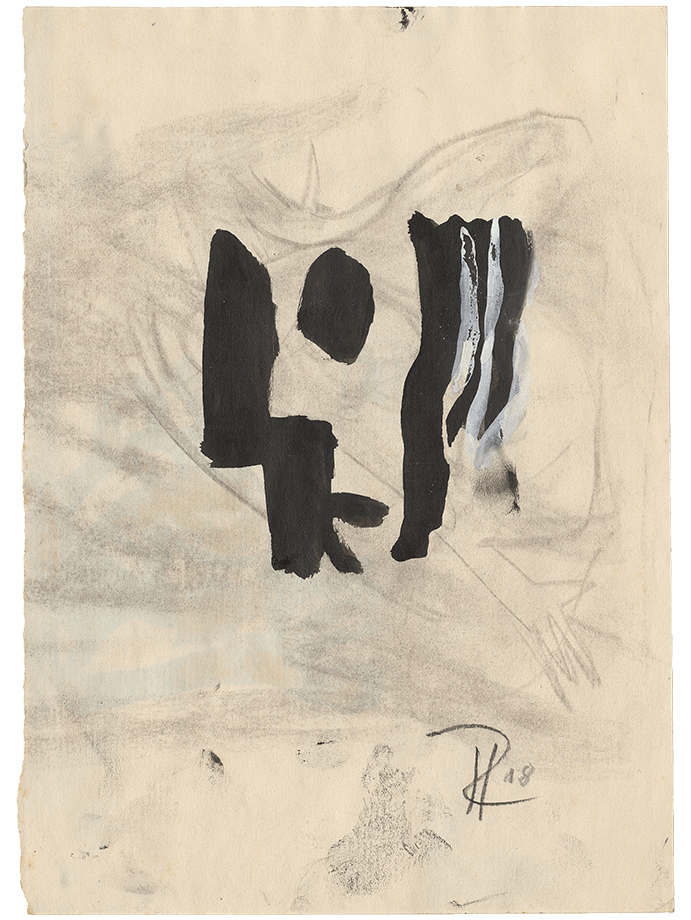Hans Richter, who lived in Zurich from autumn 1916 until spring 1919, became the chronicler of both the inner and the extended circle of Dadaists with his numerous portraits. From the first drawings he had made as a fourteen-year-old, depicting friends, classmates, teachers, and members of the family, portraiture had become the genre most familiar to him. A chronological view of Richter’s portraits clearly outlines his way into abstraction, which the artist came to pursue quite late in his career. The striking figurative likenesses of “Oberdada” (Grand-Dada) Johannes Baader and “Dadasoph” Raoul Hausmann date from Richter’s years in Berlin.
It was a period of transition in which Richter painted his Visionäre Porträts (Visionary Portraits), a whole series of which he showed in a group exhibition at the Kunstsalon Wolfsberg—twilight pictures with hardly discernible colours for which the artist relied on his inner eye rather. Subsequent portrait drawings such as those of Han Coray, Tristan Tzara, and Walter Serner oscillate between the abstracted and the abstract and are precursors of Richter’s Dada Heads. The decisive impetus for the Dada Heads’ austere form came from Ferruccio Busoni, who had immigrated to Switzerland in 1915. The Italian pianist, composer, and conductor advised Richter to apply the musical counterpoint principle to his drawings, because he regarded the artist’s experiments with positive and negative forms, his “obsession with black and white,” to be in line with this approach. Five of these Heads feature prominently in both the French and the German edition of Dada 3, where they were published for the first time. Considering Richter’s passion for portraits it comes as no surprise that he subsumed later memories of people accompanying him through his life under the book title Köpfe und Hinterköpfe (Heads and Backs of Heads).
It was during his first phase of abstraction that Richter met Viking Eggeling—an experience that directly triggered his commitment to experimental film. The stage sets he painted together with Hans Arp for the eighth Dada soirée in the Kaufleuten Hall in 1919 seem to anticipate his future artistic achievements. “Arp and I, he from one side and I from the other, began to paint black abstractions on endless strips of paper which were about two meters high. Arp’s forms resembled giant cucumbers. I followed his model, and we finally painted kilometers of ‘cucumber plantations,’ as I called them, until we met in the middle. The whole thing was then nailed onto pieces of wood and rolled up for the performance” (Richter). The set was used for an act of Laban’s dancers to whom the Dadaists had artistic and personal affinities. Richter regarded the dance school established by Rudolf von Laban in Zurich as a truly “heavenly” counterpoint to the “earthly headquarters” in the Café Odeon. These “aventures célestes” found expression in numerous friendships and alliances such as Richter’s marriage to the dancer Maria Vanselow.
Provenance: Donation from Frida Richter from the artist’s estate, 1977. The Kunsthaus Zürich’s holdings comprise forty-one drawings by Hans Richter from 1916 to 1918.
First exhibitions: Zurich, Kunsthaus, Dada in Zürich, 1980; Berlin, Akademie der Künste, Zurich, Kunsthaus, Munich, Städtische Galerie, Hans Richter, 1982.
→ Hans Richter, Kaiser Wilhelm als Befehlshaber des Todes [Emperor Wilhelm as the Commander of Death], Z.Inv. 1977/44
→ Hans Richter, poster design for the 1st Dada Exhibition at the Galerie Corray, DADA V:80
→ Viking Eggeling, Komposition, Z.Inv. 1970/2


